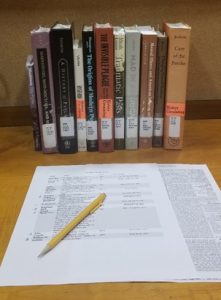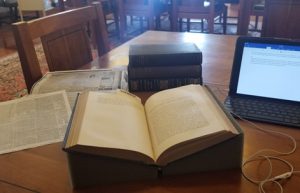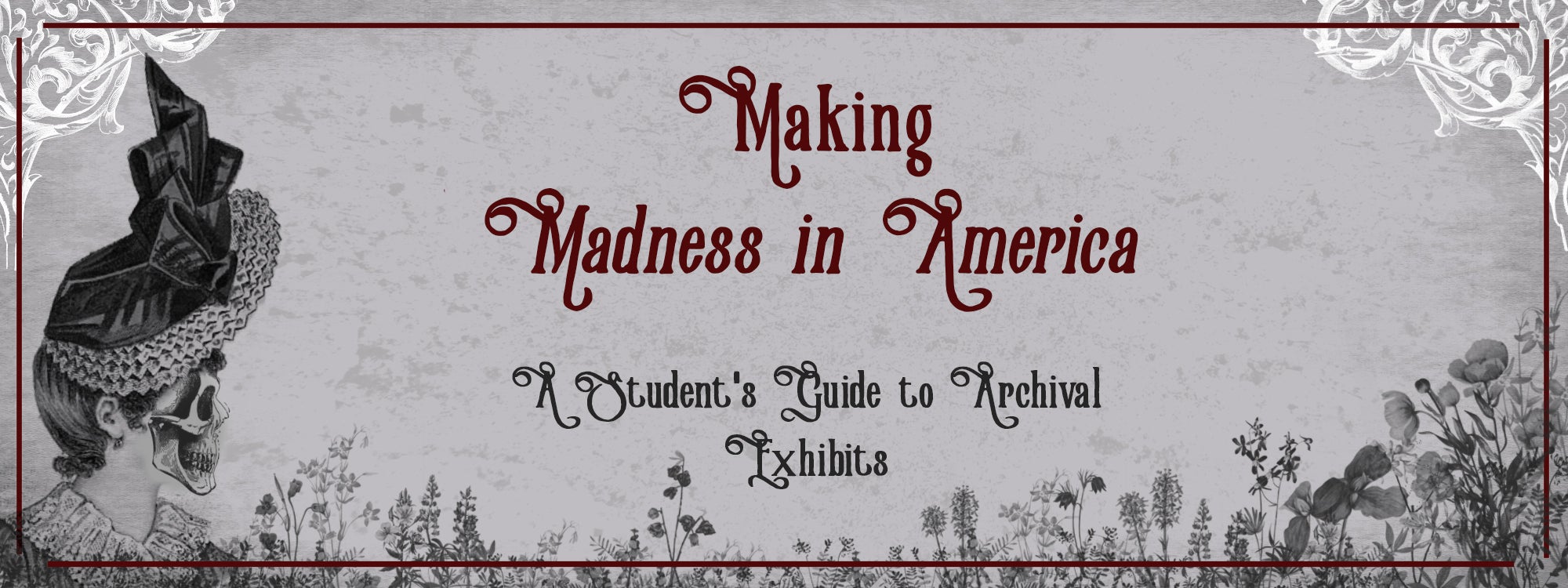Making “Madness in America:” A Student’s Guide to Archival Exhibits
Contributed by Tess Will, Laupus Library History Collections Intern
As a part of my internship in the History Collections at East Carolina University’s Laupus Health Sciences Library, I have been tasked with creating an original exhibit to highlight some of our archival materials. An archival exhibit is totally different than a museum exhibit, but it still follows the same rules. Exhibits must be well researched, visually appealing, and present a truthful history. People are drawn to exhibits with exciting objects and images, but it can be difficult with just books! I wanted to share my process here so (hopefully!) I can help another student like myself in their exhibit process.
First, I had to choose a topic for my exhibit. When deciding on an exhibit topic, it is important to keep many things in mind. The most important factor is ensuring that you have access to a sufficient amount of materials related to your topic. A good archival exhibit shows off your collection, so you want to make sure that you have what you need.
 Try to pick a topic that interests you! Researching something you like makes the process much more fun. I narrowed down a few topics of interest and finally selected the treatment for the mentally ill during the nineteenth century. The Victorian Era is fascinating to study, whether you are researching culture, politics, religion, or medicine. My choice happened to coincide perfectly with the arrival of a traveling exhibit from the National Library of Medicine (NLM) which will be installed this summer (2019). My exhibit will provide background information for associated materials that will be on display with the NLM exhibit, which is entitled The Literature of Prescription: Charlotte Perkins Gilman and “The Yellow Wall-Paper.”
Try to pick a topic that interests you! Researching something you like makes the process much more fun. I narrowed down a few topics of interest and finally selected the treatment for the mentally ill during the nineteenth century. The Victorian Era is fascinating to study, whether you are researching culture, politics, religion, or medicine. My choice happened to coincide perfectly with the arrival of a traveling exhibit from the National Library of Medicine (NLM) which will be installed this summer (2019). My exhibit will provide background information for associated materials that will be on display with the NLM exhibit, which is entitled The Literature of Prescription: Charlotte Perkins Gilman and “The Yellow Wall-Paper.”
The second step is research. Any good student of history knows how to research, and it is something I do quite often! I started by looking within the general collection of Laupus Library and identified secondary sources for information for the labels. Having this background information helps you decide where you want to go with the exhibit. Once you’ve identified the secondary sources and perused them, you should have a better idea of what types of materials/topics you’d like to include in your exhibit.
Dive in to the primary source materials! In my opinion, it is one of the most exciting parts of exhibit making because you get to see directly into the past. If you have trouble reading 19th and 20th century cursive, maybe stick with books and newspapers rather than letters or diaries in your collection. I stuck with books written by physicians about the care of the mentally ill from the early 1800’s to the very beginning of 1900. By doing this, I was able to see how medical beliefs and practices changed over time, and I was able to choose what I wanted for my exhibit.
The third step is designing the exhibit. Having a space to play around with your objects can help immensely with your creative process. I am a very visual learner, so seeing and touching things helps me a lot! After I had my layout the way I wanted it, I was able to go ahead and make my labels. I wrote my labels based on the information I wanted to include and had my supervisor, Layne Carpenter, Archivist and label making Goddess, check it all out. She made edits and I included them in the final draft of my labels. This is also where I decided on a final name for the exhibit.

Here at Laupus, we typically use Adobe Photoshop or Illustrator to make our labels because we find it easier to get the correct size this way. Microsoft Word does work for label making in a pinch or for those who are not comfortable with Photoshop. It took a lot of work for me to create something I liked in Photoshop! To stay true to the time period, I worked with colors that would have been typically used in the Victorian Era. This adds to the authenticity of your work but can be a huge pain when trying to make a poster and design labels. I spent a whole work day on designing my poster and the labels to match it. Labels can be made to fit different plexiglass holders, as tent cards, or even just to lie flat in the case. I chose to not put my labels in holders due to size constraints.
Installing the exhibit is the most exciting and quickest thing you will do. The whole exhibit was installed and photographed in 20 minutes. No matter how small your exhibit is or what it contains, it is amazing to see your hard work on display for everyone to see, even if it is a little nerve-wracking. I encourage all Public History or Archives students to make their own exhibit. It truly helps you get to know your collection and is a fun way to present it to the public!

Madness In America: Mental Health Care During the Victorian Era will be on display on the second floor of Laupus Health Sciences Library through July 31, 2019.
Tess Will is a senior at East Carolina University and is a History major with a minor in Public History. She works part time as a docent at The Country Doctor Museum in Bailey, NC and has completed an internship there. Last summer, she worked as a State of North Carolina intern at the Queen Anne’s Revenge Conservation Lab in Greenville, NC. Currently, she is working as in intern in the History Collections of Laupus Library to round out her Public History experiences. She intends to apply to North Carolina State University for Graduate School and plans to start her Master of Arts in the Fall of 2020.
Selected Bibliography
Kirchhoff, Theodor, Handbook of Insanity for Practitioners and Students. New York: Wood, 1893.
